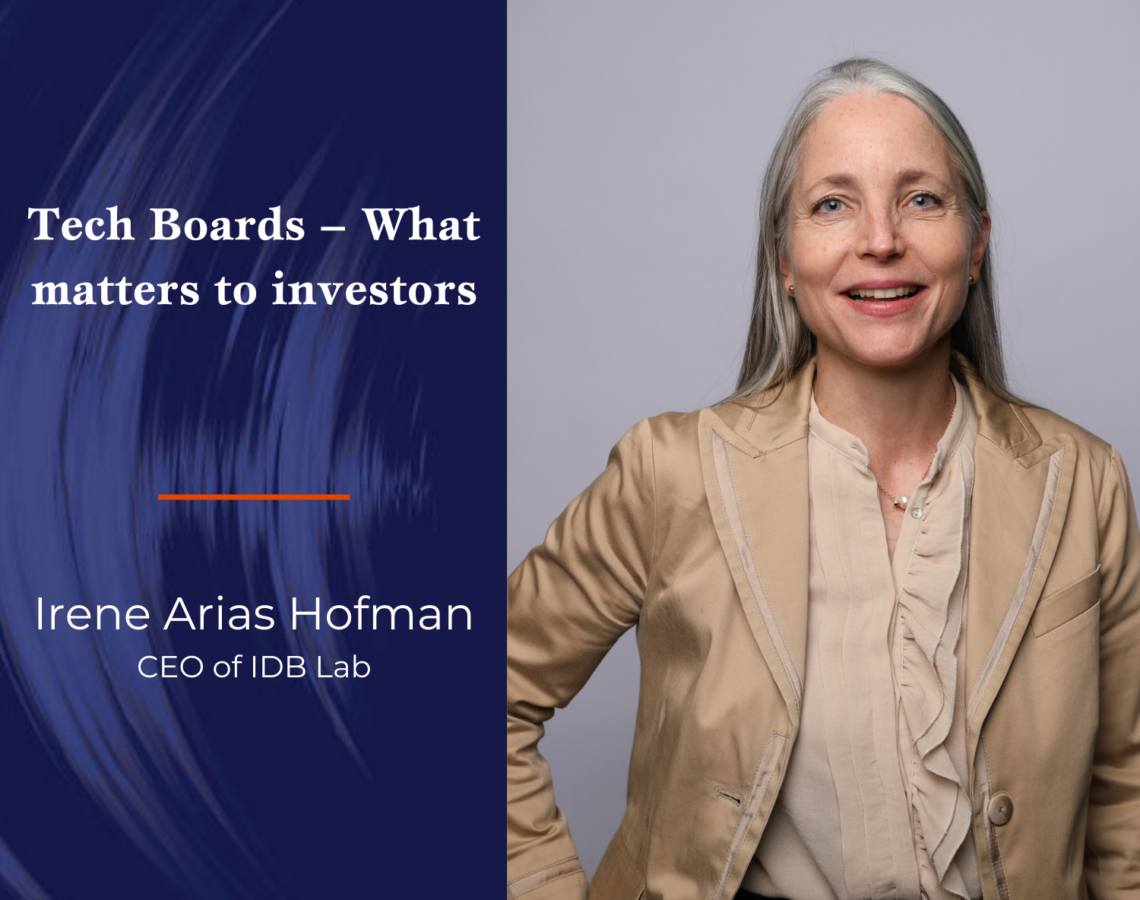Tech Boards – What matters to investors

Directors line up to serve on attractive, young, and agile Tech companies. Founders and their teams pitch for investment. Governments count on Tech companies to secure a nation’s future wealth. Boards of Tech companies have a crucial role to play. What matters to investors? What are the criteria for selecting candidates for the boards in their portfolio? How do investors measure progress? What does good look like for investors?
In this podcast, Dr Sabine Dembkowski, Founder and Managing Partner of Better Boards, discusses tech boards with Irene Arias Hofman, CEO of IDB Lab, the innovation and venture laboratory of the Inter-American Development Bank Group. Their purpose is to discover new ways to drive social inclusion, environmental action and productivity in Latin America and the Caribbean. IDB Lab leverages financing, knowledge, and connections to support early-stage entrepreneurship, foster the development of new technologies, activate innovative markets, and catalyse existing sectors. Irene previously worked for 20 years at the IFC, the private sector arm of the World Bank Group, managing the Financial Institutions Group and the LAC region with its 16-billion-dollar portfolio. She focuses on innovation and technology, venture capital, and organisational development.
“We do care a lot about the principles, the values, the incentives”
Irene begins by outlining that when evaluating tech boards, especially in startups, investors focus on several key elements. Using her organisation’s portfolio as an example (which includes startups typically at Series A or B stages), she explains that they pay close attention to the governance of both the startups and the venture capital (VC) funds they often invest alongside. They believe that the governance of portfolio companies and VC funds is crucial, although the governance of each differs significantly. She explains this, starting with startups, which typically have external boards of directors and shareholders, so they closely evaluate their structure, decision-making processes, and governance practices. In contrast, VC funds operate as private partnerships with distinct legal rules and governance standards, but their principles, values, incentives, and general partner composition are equally important. Although the governance models differ, both need alignment with long-term success for investors.
“They need to a bring in a whole set of other aspects…. that they didn’t have to worry about when they were just a two people team”
From an investor’s perspective, Irene describes how a good board in a startup balances technical expertise with broader strategic and corporate skills. In the early stages, many startups (especially tech-focused ones) have founders on the board, leading to a heavy emphasis on technical knowledge. While this is essential initially, she explains that as the company grows and becomes more institutionalised, the board needs to expand its skill set to include governance, organisational management, social skills and strategic foresight—areas for board effectiveness that founders may not have needed to prioritise when they were a small team.
In contrast, fintech startups (which make up over 25% of their organisation’s portfolio) often face the opposite challenge, as they tend to have boards strong in traditional finance skills but that may lack technical expertise. As these companies grow, their boards must evolve, incorporating new skills to manage complex regulations, international expansions, and government relations. She illustrates this with the example of Nubank, which grew from a startup to one of the largest digital banks in the world. As it scaled, it needed board members who could handle banking regulations and large-scale expansion, skills not required at the outset but crucial as the company matured. Ultimately, a good board adapts alongside the startup, continuously evolving to meet the company’s changing needs as it transitions from a startup to a more established corporate entity. She advises that the right mix of skills and experience is key to navigating this growth successfully.
“They have more control… or more choice than maybe they think in terms of who’s on the board”
Irene then outlines how successful boards differ from struggling ones in several key ways. First, they ensure the right fit of board members rather than simply accepting any investor who offers capital. She notes that startups often feel they have limited control over their board composition, especially when large investors demand board seats. However, successful startups are, in fact, deliberate about selecting board members who bring real value, particularly in terms of industry expertise and specialised knowledge. As venture capital markets evolve, board development is necessary as generic solutions are no longer enough. Boards must guide startups through increasingly complex and specialised challenges, adapting their strategies to local markets or industry nuances.
Another critical role of boards that Irene mentions is in fundraising. Since startups are always looking ahead to the next round, board members who nurture investor relationships and provide feedback between funding cycles are invaluable. These board members help identify potential roadblocks and steer the company toward the milestones needed to attract future investments.
“Only 6.2% of board seats in unicorn companies are held by women”
Board diversity is also a distinguishing factor. Data shows that companies with women on their boards perform significantly better, yet Irene notes that women still hold only a small fraction of board seats in unicorn companies. Successful startups recognise the importance of diversity early on and work to ensure it is reflected in both the C-suite and the board, preparing the company for sustainable growth and stronger financial returns. Irene points out that a cultural mindset also sets successful boards apart. A startup’s mission and commitment to the long-term vision are key, and understanding that early-stage ventures will experience ups and downs is essential. These boards are not overly conservative but embrace the risk and uncertainty of startups. Since 75% of VC-backed companies fail, she notes that board members must be willing to weather failures and stay focused on the bigger picture. Too risk-averse boards can clash with the founders, hindering progress at crucial moments, especially in the early stages before a startup has a proven track record. She summarises how successful boards prioritise the right mix of expertise, play an active role in fundraising, embrace diversity, and align culturally with the startup’s mission and vision.
“It’s become trendy, and it can be good to say you are on the board of a high-growth tech startup”
A good board member in the startup context needs to be highly available and committed. Irene points out that while it has become ‘trendy’ to be on the board of a high-growth tech company, the real value comes from being genuinely invested in the company’s success. Building trust with the founders and fellow board members is essential, as startups frequently face make-or-break moments.
She explained that fundraising is one key area in which board members add value. Leveraging personal networks to bring in co-investors and introducing potential future investors is a significant contribution, especially during critical funding rounds. Another critical component is offering deep industry expertise, which helps guide the startup through its early stages and prepares it for eventual growth and maturity. As the startup progresses, board members need to bring insights from the corporate world to help the company transition into a more established entity. This includes staying ahead of regulatory developments. In sectors such as AI, where regulation is rapidly evolving, board members play a crucial role in ensuring the startup builds robust governance frameworks early on. Her advice is that being proactive about regulatory compliance can save startups considerable challenges down the road, especially in regions with stringent regulations, such as Europe. Overall, the best board members combine hands-on involvement with strategic foresight to guide startups through the highs and lows of their growth journey.
“You really want to know: are you gonna build a sustainable business”
When it comes to tracking a startup’s progress, Irene relies on a few key KPIs that provide a solid understanding of the company’s health and sustainability. First, she describes how the burn rate is critical. If a startup does not have at least nine months of runway, it is a red flag, so keeping a close eye on cash flow and ensuring the company can forecast its burn rate accurately is crucial to prevent sudden financial crises. She then moves on to unit economics as another fundamental measure. This is not just about looking at revenue and cost of goods sold but understanding the profit earned on each unit sold, which involves deeper calculations, such as determining the lifetime value (LTV) of a customer—how much a customer will spend over their lifetime with the product or service. Paired with the churn rate, which measures how frequently customers stop using the product, these two metrics clearly show long-term sustainability. She gives the example of a health tech investment in Mexico. While growth appeared strong, a high churn rate signalled deeper issues that must be addressed for sustainable success.
She lists customer acquisition cost (CAC) as another vital KPI, especially in early-stage startups, because how much a company spends on marketing, promotions, and incentives to acquire customers significantly impacts profitability. Many startups aiming for large addressable markets struggle to control CAC, and so a smart, efficient marketing strategy is essential to managing these costs. This, she explains, is why board members with marketing expertise can be so valuable in complementing a board’s technical and financial knowledge. In summary, she recommends that startups focus on KPIs such as burn rate, unit economics (particularly LTV and churn rate), and CAC. These metrics offer a detailed view of whether a startup is on a path to becoming a sustainable, scalable business and can help boards and leadership teams make informed strategic decisions.
The three top takeaways from our conversation are:
- As a startup, you may be able to pick your board members more than you think, so do not feel pressure to give up board seats to investors to get investment. It has to be a good match to build the right skill mix.
- That skill mix will evolve rapidly, just as the startup does. You will have to pivot your strategy. For example, if you become very successful, then very quickly, you need to become much more sophisticated in how you are run. So be ready to evolve, including evolving the composition of your board.
- Be mindful of bringing in board members who believe in your vision for the company and can contribute diverse views.
Remember to subscribe and never miss an episode of the Better Boards Podcast Series. It’s available on Apple, Spotify, or Google.
To find out how you can participate in the Better Boards Podcast Series or for more information on Better Boards’ solutions, please email us at info@better-boards.com.



